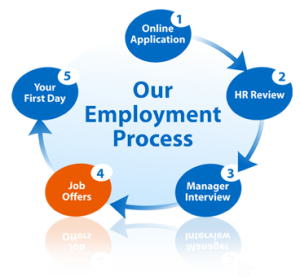The prospect of choosing between multiple job offers may seem unlikely these days, given all the talk of joblessness and the real unemployment rate of 15.1% (counting people who have given up looking for work, and those working part-time who wish they had full-time jobs). But career coaches say they are seeing the job market pick up, at least for some workers. “Things are turning around,” says Kate Wendleton, founder and president of national job coaching organization The Five O’Clock Club. Given the slightly improved U.S. economy, some workers who have been unhappy in their jobs for a long time, are making moves. “That opens up a chair,” says Wendleton.
Read our previous blog => HOW TO HIRE LIKE A PRO
In fact, says Wendleton, if you’ve run an effective search, by the time you have an offer, you should have several. Though to me, this idea seems excessive, Wendleton pushes her clients to have between six and ten prospects in the works. If you can do that, she says, “you’ll be seen as a player.” One of the chief mistakes job hunters make, she says, is pursuing only one opportunity at a time. Senior people fall into this trap more than those who are junior on the career ladder. “It happens with the ego of a senior person,” she says. “They just want to declare victory and go ahead.”
That can lead to drastic unhappiness, says Wendleton. At any level, you should do exhaustive research about a job before stepping into it. Inquire about the values of the company and what will be expected of you, including hours worked. Talk to the person who used to hold the job, if you can track her down, and get as much information as you can about the person to whom you will be reporting.
Wendleton says the decision should hinge on which position will do your career the most good in the long run. Though job seekers are almost always heavily swayed by money, she advises looking at how a job will affect both your day-to-day life and your future career prospects. A client of Wendleton’s who worked in financial consulting, wound up with three offers at the same time. One of the jobs paid $325,000 a year, and would have required her to travel constantly. The second job would have required less travel; it paid $225,000. The third job, for a rating agency with reasonable hours, paid $125,000. Because Wendleton’s client had a small child, and she knew the rating agency job could lead to other opportunities, she chose the lower-paid position so she could spend more time with her child. Ideally, you would have a 40-year career plan, but often a five-year plan is the best you can do.
Of course it can be a tough feat to manage all your negotiations so that the job offers ripen at exactly the same time. Ruth Robbins, a Five O’Clock Club coach in New York, recently had a client who worked in media audience development, who was talking to three different companies. One was a small, quirky magazine that didn’t pay well, another was his old employer, who wanted him to return on an hourly basis, and the third was a large, well-paying publication. The client most wanted to work at the large publication, but he hadn’t yet gotten an offer. His next move: stall for time. He told the other two companies that he wasn’t ready to give them an an swer and then let the third place know that he had two other offers. “It was a lot of juggling and a lot of stress,” says Robbins. But the third offer came through and the client took it. “He really clinched the best offer he could,” says Robbins.
swer and then let the third place know that he had two other offers. “It was a lot of juggling and a lot of stress,” says Robbins. But the third offer came through and the client took it. “He really clinched the best offer he could,” says Robbins.
One pointer Robbins adds: Though she subscribes to the Five O’Clock Club credo of having 6-10 prospects in the works at once, she says the half dozen can include checking in with a recruiter on a regular basis, going to networking meetings, activity in an industry organization, and cultivating LinkedIn connections. “It does not necessarily mean six to ten job interviews,” says Robbins. “That’s ideal, but if you have three or four things happening, that’s terrific.”
Another example of a real life story: Robbins had a client who had worked as a director at non-governmental organizations. She had two offers that were ripening at the same time. One of them was a non-profit in Washington, D.C., that wanted her as a director. But she had a school-age son in New York, and she was reluctant to uproot him. At the same time, a women’s political rights group affiliated with the United Nations, was interested in her. But that organization was full of bureaucratic hoops, and an offer was not forthcoming. The woman told the D.C. office that she needed more time, and pressed the New York organization to make her an offer, saying she had a competing possibility elsewhere. It took an extra three weeks, but she was able to get the job she wanted.
Robbins says the trickiest part of the negotiation came when her client told the D.C. job that she needed more time. That organization had a ready list of other candidates waiting in the wings. The woman came up with stalling tactics that didn’t require her to sacrifice her integrity. She asked substantive questions about the work, like the structure of the organization’s reporting protocol, and she said she needed to confer with her ex-husband about child custody arrangements.
Sometimes candidates have more than one offer, but neither job is a good fit. Robbins had a business analyst client who was talking to a fancy department store chain where he would have had to dress formally every day. He was also negotiating with another outfit about a permanent freelance position where he would have flexibility and could wear less formal attire. He wound up taking the freelance job, but not liking it, and is back to looking for a job. Still, turning down the department store was the right move, says Robbins. He wouldn’t have been happy there, and the freelance job gave him another entry for his résumé. “The lesson there is sometimes you don’t get the perfect world,” says Robbins.
This page originally appeared on Susan Adams Page






